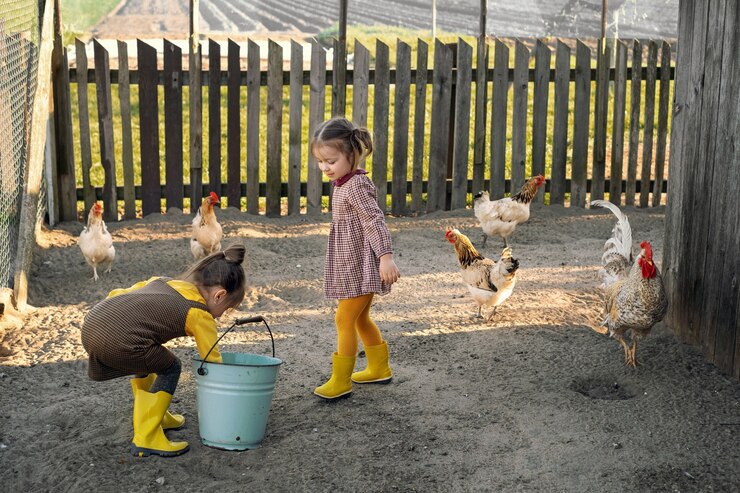How to Build a Chicken Habitat for Maximum Farm Efficiency: A Step-by-Step Guide

Raising chickens can be highly rewarding, but efficiency is key to maintaining a productive and sustainable farm. A well-designed chicken habitat improves flock health, boosts egg production, and reduces maintenance efforts. Whether you’re starting fresh or upgrading an existing setup, this guide will walk you through everything you need to know about building a chicken habitat that enhances farm efficiency.
Why a Well-Designed Chicken Habitat Matters
A properly constructed chicken habitat provides your flock with safety, comfort, and the right conditions for optimal productivity. Poorly designed coops can lead to increased disease, higher feed waste, and unnecessary labor. By planning ahead, you can create an environment that benefits both your chickens and your farming operations.
Key Benefits of an Efficient Chicken Habitat
- Healthier Flock – Good ventilation and cleanliness reduce disease risks.
- Higher Egg Production – Stress-free chickens lay more eggs.
- Lower Maintenance – A smart layout minimizes daily chores.
- Better Space Utilization – Maximizing space means more chickens without overcrowding.
Now, let’s dive into the step-by-step process of building an efficient chicken habitat.
1. Choose the Right Location
The location of your chicken habitat significantly affects its efficiency. You need to find a spot that offers:
- Good Drainage – Avoid low-lying areas where water collects.
- Adequate Sunlight – Chickens need sunlight for warmth and egg production.
- Wind Protection – Placing the coop near natural windbreaks like trees or a barn can prevent cold drafts.
- Easy Access – A location close to your house or other farm buildings makes daily care easier.
If you’re planning a mobile setup, consider a portable chicken coop that allows you to move your flock to fresh ground periodically. This approach improves soil health and reduces the risk of parasites.
2. Design a Spacious and Secure Coop
A well-built coop serves as the backbone of your chicken habitat. The key is to balance space, security, and functionality.
Space Requirements
Overcrowding leads to stress and aggressive behavior, so providing enough space is essential. A good rule of thumb is:
- 4 square feet per chicken inside the coop
- 8-10 square feet per chicken in the run
Ventilation and Insulation
Proper ventilation prevents moisture buildup, which can cause respiratory issues. Install vents near the roof to promote airflow while keeping drafts away from roosting areas. In colder climates, use insulated walls to retain warmth during winter.
Predator-Proofing
Chickens are vulnerable to predators such as foxes, raccoons, and hawks. The Backyard Poultry Predator Protection Guide offers expert tips on fortifying chicken coops, deterring common predators, and ensuring flock safety year-round. Secure the habitat with:
- Heavy-duty wire mesh on windows and ventilation openings
- A buried fence skirt to prevent digging predators
- Lockable latches on doors and nesting boxes
3. Create a Comfortable Nesting and Roosting Area
Chickens need dedicated areas for laying eggs and resting. If these areas are not well-designed, your flock may become stressed or lay eggs in unwanted places.
Nesting Boxes
- Provide one nesting box for every 3-4 hens.
- Keep them dark and private to encourage egg-laying.
- Line boxes with straw or pine shavings for comfort.
Roosting Bars
- Install elevated wooden bars for chickens to sleep on at night.
- Each chicken needs about 8-12 inches of space on a roost.
- Position bars higher than the nesting boxes to prevent hens from sleeping in the nesting areas.
4. Build a Safe and Functional Outdoor Run
The outdoor run allows chickens to forage, exercise, and express natural behaviors, contributing to their well-being.
Key Features of an Efficient Chicken Run
- Secure fencing – Use wire mesh with a 1/2-inch gap to keep out predators.
- Covered top – Prevents aerial predators and protects from harsh weather.
- Dust bath area – A dry, sandy spot helps chickens clean themselves and prevent parasites.
5. Set Up an Efficient Feeding and Watering System
A well-designed feeding and watering system reduces waste and labor.
Feeders
- Use elevated or treadle feeders to prevent rodents from accessing food.
- Position feeders in a dry, shaded area to prevent spoilage.
Waterers
- Nipple or cup-style waterers keep water clean and reduce spillage.
- In colder climates, use heated waterers to prevent freezing.
6. Implement a Waste Management System
Managing chicken waste efficiently keeps the habitat clean and odor-free while improving soil health.
Composting Chicken Manure
Chicken manure is high in nitrogen and can be a valuable fertilizer when composted properly. To do this:
- Collect soiled bedding and manure regularly.
- Mix with carbon-rich materials like straw or leaves.
- Let it decompose for several months before using it in the garden.
7. Maintain and Monitor the Habitat
Once your chicken habitat is built, regular maintenance is crucial for long-term efficiency.
Daily Tasks
- Check food and water levels.
- Collect eggs.
- Observe flock behavior for signs of illness or stress.
Weekly Tasks
- Clean out nesting boxes.
- Inspect for structural damage or predator entry points.
Monthly Tasks
- Deep-clean the coop.
- Refresh bedding materials.
- Evaluate egg production and flock health.
Read Also: Halal Snacks: Where to Get The Best Halal Hot Chicken
Final Thoughts
Building an efficient chicken habitat requires thoughtful planning, but the benefits are worth the effort. A well-designed coop and run create a healthier environment, reduce daily labor, and improve farm productivity. Whether you choose a stationary structure or a portable chicken coop, the key is to balance space, security, and functionality.
By implementing these strategies, you’ll ensure that your flock thrives while optimizing your farm’s efficiency.

Diamond Painting Apps & Digital Tools for 2025 Artists

Pallet Wood Sourcing: Ethical and Sustainable Practices

Understanding Cost-Benefit Analysis for Project Feasibility

Accelerating drug discovery through the DEL-ML-CS approach

AI in Marketing Is No Longer a Buzzword — It’s the Strategy

Top Applications of Temperature Sensors in Household Appliances

Discover the Anne K. Kroeger Pool in Piedmont: A Hidden Gem for Swimmers

What Fast-Growing Brands Get Right About 3PL Logistics








